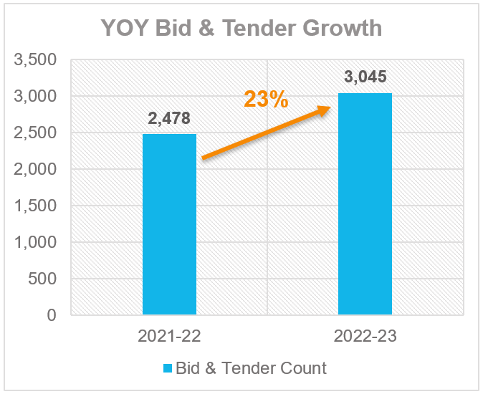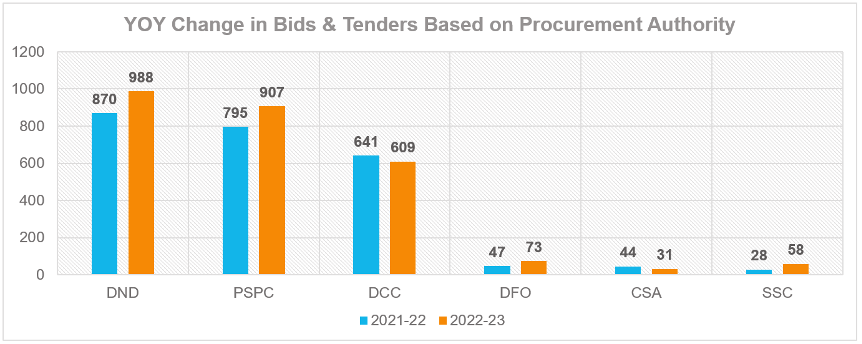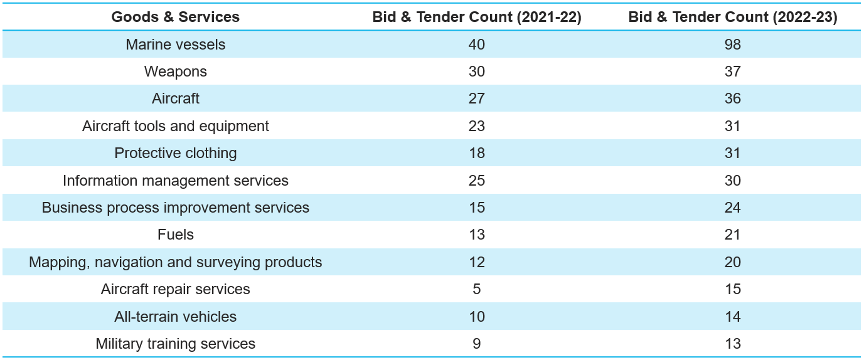The State of Canadian Defence Purchasing for 2024

Every year, Canadian defence organizations spend billions of dollars purchasing a wide variety of goods and services. Indeed, the Department of National Defence (DND) is responsible for well over 10,000 contracts per year and will spend an estimated $26.5 billion Canadian Dollars (CAD) in 2023-24. However, Canada’s defence budget, as well the broader Canadian federal budget, is facing proposed cutbacks. Having a comprehensive understanding of the market will be crucial considering these potentially challenging economic conditions.
Current Challenges in the Canadian Defence Market
Going into 2024, the defence industry in Canada is entering into a period of uncertainty, driven by the Government of Canada’s recent announcement to make sweeping budget cuts. All federal departments and agencies are being asked to collectively cut $15.4 billion CAD over five years. Although the Canadian Armed Forces are exempted from budget cuts in 2023, DND will still be responsible for shaving around $900 million CAD per year off its budget over the next four years. Included in the federal government’s $15.4 billion CAD cutback is a 15 percent reduction in travel expenses and outsourcing, particularly management consulting, totaling $7.1 billion CAD over five years. For DND, this will mean reducing consulting services and other related costs by about $750 million CAD per year.
As a NATO member, Canada is also falling short of the organization’s target for its members to spend at least two percent of their gross domestic product on defence annually. Canada will spend at most 1.38 percent of its GDP on defence this year. This comes at a time when major global conflicts are breaking out in Europe and the Middle East, and when Canada has already committed to modernizing NORAD defences. The proposed cutbacks may require DND to slow down some of its projects. According to Defence Minister Bill Blair, cutbacks “may actually require some of the investments that we know we have to make — we may have to make over a longer period of time in response to the current fiscal situation.”
However, Minister Blair remains steadfast that overall defence spending will continue to grow year-over-year. “We'll continue to invest in [the Canadian Armed Forces], so that they have the tools they need to do their jobs. Any claim that Canada is 'cutting' defence spending is not accurate, because overall defence spending has increased and will continue to increase,” Blair wrote on the social media platform X (formerly Twitter).
Canadian Defence-Oriented Purchasing Growth
Considering the challenges facing Canada’s defence industry, it is crucial that the vendor community and other industry stakeholders understand where money and opportunities are flowing. An analysis of bids and tenders in GovWin IQ reveals that the number of defence-oriented procurement opportunities increased 23 percent between July 2021-June 2022 and July 2022-June 2023. Analyzed bids and tenders for defence-oriented projects were either procured by the following organizations, supported by them, done in partnership with them, or involved them in a key capacity:
- Department of National Defence
- Defence Research and Development Canada
- Defence Construction Canada
- Canadian Armed Forces
- Canadian Army
- Royal Canadian Navy
- Royal Canadian Air Force
- Canadian Special Operations Forces Command
- Canadian Coast Guard (Departments of Fisheries and Oceans)
- Canadian Space Agency
- Canadian Security Intelligence Service
Defence-related opportunities grew 23 percent from 2,478 in 2021-22 to 3,045 in 2022-23.
Defence Bids and Tenders by Purchasing Authority
An agency’s involvement in a procurement does not automatically mean it is the procurement authority. Public Services and Procurement Canada (PSPC), the purchasing arm of the federal government, releases many opportunities on behalf of its fellow departments and agencies. For defence-oriented bids and tenders, DND is the top procurement authority, followed by PSPC, Defence Construction Canada (DCC), Fisheries and Oceans Canada (DFO), the Canadian Space Agency (CSA), and Shared Services Canada (SSC). DFO oversees the Canadian Coast Guard, which explains its presence on this list. SSC is responsible for managing information technology infrastructure for the federal government and often releases solicitations on behalf of other departments and agencies. The following chart represents changing buying behaviors by procurement authority for defense-related opportunities between 2021-22 and 2022-23.
Several procurement authorities released more bids and tenders in 2022-23 than they did in 2021-22, including DND, PSPC, DFO, and SSC. On the other hand, DCC and CSA released less bids and tenders in 2022-23 than the prior year.
Areas of Growth in the Canadian Defence Market
While overall defence-oriented Canadian government contracts grew by 23 percent between 2021-22 and 2022-23, certain goods and services were more in demand than others, as demonstrated by the following table.
Several procurement authorities released more bids and tenders in 2022-23 than they did in 2021-22, including DND, PSPC, DFO, and SSC. On the other hand, DCC and CSA released less bids and tenders in 2022-23 than the prior year.
Key Takeaways for Canadian Government Contractors
Making cuts to Canada’s defence budget will necessitate tough decisions, as any reduction in funding will inevitably impact the operational readiness of the Canadian Armed Forces. While DND’s spending on professional services has increased, management consulting represented less than two percent ($72 million CAD) of service spending last year. The Canadian Armed Forces are also short about 8,000 full-time troops, which has reduced their in-house capacity, so cutting back on outsourcing could further disrupt operations. Furthermore, most other NATO members are increasing their defence spending in the wake of recent global conflicts, and Canada has been under significant pressure from other members to do the same. Canada’s decision to pare back defence expenditures will have consequences, which may lead to a course correction or policy reversal in the future.
As the Government of Canada and the vendor community grapple with upcoming budget cuts, insights like historical spending trends, forecasted budget initiatives and real-time project updates may factor heavily into a company’s success in the Canadian defence market. In other words, companies with a comprehensive understanding of the market may fare better than their less informed counterparts, particularly in the face of challenging economic conditions. If projects are delayed, canceled or re-bid, how can a company be the first to know? If money is earmarked for a particular project, how can a company find out more details? To diversify or build its portfolio, how can a company explore historical contract spend and areas of growth?
This type of market intelligence can inform a company’s business development strategy and help allocate resources for maximum impact and is available in GovWin IQ, the market leader for Canadian and U.S. contractors seeking to confidently manage and grow their government business. Their industry-leading market intelligence platform is uniquely built, backed, and continuously updated by market analysts and industry experts that gather and analyze first-hand information from government decision-makers.
Learn how you can gain early access to opportunities, network with teaming partners and buyers, and leverage powerful market intelligence – all supported by their team of experts – to beat the competition and win more government contracts.

Deltek Project Nation Newsletter
Subscribe to receive the latest news and best practices across a range of relevant topics and industries.

 Log In
Log In
















